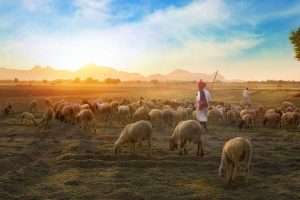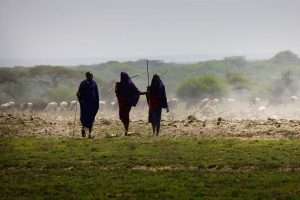Cashmere, one of the finest types of wool in the world!
Here you will discover everything about Cashmere wool, a noble fiber that is rare and luxurious. The description World’s Finest Wool fits Cashmere perfectly.
Would you like to - Here you will find out!
First things first! What is Cashmere fine wool?
Cashmere is the name given to the precious hair of the cashmere goat.
The term cashmere wool is somewhat contradictory because the term wool in textile manufacturing is strictly speaking assigned to the sheep.
The term cashmere wool is somewhat inaccurate because, strictly speaking, the term wool is associated with the fibers coming from sheep. We must be careful to distinguish wool from sheep and the fine precious fibers that come from Cashmere goats, Alpacas, Yaks, Angora Rabbits, or Vicuñas.
The fine hairs mentioned here have in common that they have a scale edge height that is only about half as high as that of wool.
They also differ in the number of scales per unit length and characteristics. Therefore, cashmere feels much softer and smoother than wool for the same diameter.
The name is derived from the region of Kashmir. The native species of horned cashmere goats, with its 20 breeding forms, occur in white, gray, brown or black. It belongs to the family of domestic goats, a subspecies of wool goats. In its homeland, cashmere wool has been handcrafted into high-quality textiles since about 1000 BC.

The Changthangi or Pashmina goat grows a thick warm fleece and is a breed of goat from Tibet or neighbouring areas in the Ladakhi Changthang, usually raised for cashmere wool. - Wild Films India

Cashmere wool is a delicate gift of mother nature.
Cashmere fine wool comes from Cashmere goats or Pashmina goats and humans have been using it to create clothing for centuries. The term Cashmere is an anglicization of the original name of Kashmir which is the name of the region in the Himalayas where the goats come from.
The area features mountainous landscapes and temperatures as low as -40 °C during winter. Kashmir or Cashmere goats have adapted to these harsh environmental conditions and developed a very fine, warming undercoat, which is finer and much softer compared to sheep’s wool or the wool of other goat species.
Today Cashmere wool also comes from domesticated animals, which are bred in Europe because of their high-quality fur. The breeding of Cashmere goats is demanding since the weather must resemble their natural living conditions so that they form valuable undercoat.
They are usually kept in regions that are at least 4000 meters above sea level and are characterized by cold winters.
The species of the Cashmere goat belongs to the group of domestic goats and has characteristically floppy ears and small horns that are bent backward. There are approximately twenty races that belong to the type of the cashmere goat. They differ primarily due to their fur colors, ranging between brown, black, and grey. Light-colored Cashmere goats are usually bred because it is easier to color the fiber.1
Total cashmere production accounts for less than 0,5 percent of world wool production. This fact makes it clear how exclusive this fiber is.
The exquisite qualities of Cashmere wool
Fabric made of high-quality Cashmere wool is wonderfully soft and very light. It gives the feeling of a gentle embrace when it comes in contact with the skin. It is water-repellent, it has excellent thermal insulation, and the fibers are extremely fine and flexible.
The world’s finest fibers from those precious animals share the quality characteristic that they are 50 % lighter than wool. Furthermore, they differ in the number of scales per unit length and their fiber traits. Fine fibers with the same diameter feel softer and smoother than wool.
It is only right to make the distinction with modified fine wool, also known as Cashwool, where quality selections of merino wool undergo a spinning, dyeing, and stretching process, to reproduce and imitate some of the characteristics of fine Cashmere wool.
{ “@context”: “https://schema.org”, “@type”: “Article”, “mainEntityOfPage”: { “@type”: “WebPage”, “@id”: “https://www.worlds-finest-wool.com/history-of-cashmere/cashmere-wool/” }, “headline”: “Cashmere Wool”, “image”: [ “https://www.worlds-finest-wool.com/wp-content/uploads/2020/07/Raw-Cashmere-Wool-1600-670.jpg” ], “datePublished”: “Feb 6, 2020 at 01:17”, “dateModified”: “Feb 6, 2020 at 01:17”, “author”: { “@type”: “Person”, “name”: “Marco Heitner” }, “publisher”: { “@type”: “Organization”, “name”: “World’s Finest Wool”, “logo”: { “@type”: “ImageObject”, “url”: “https://www.worlds-finest-wool.com/wp-content/uploads/2020/10/LOGO-SHEEP-interlace.png” } }, “description”: “Cashmere wool symbolizes elegance and exclusivity like hardly any other natural fiber. Discover the Characteristics of this delicate gift of mother nature.” }
Why is Cashmere wool so expensive?
The fiber is quite expensive. The background is that the breeding of the goats or the cashmere wool’s extraction is very costly. To make a single cashmere sweater, the fine underhairs of up to three cashmere goats are necessary. Because the animals lose their fur only once a year but must be cared for all other months, the yield is low.
It is also essential to know that cashmere has a proud price but is considered very durable. Usually, the purchase of a few high-quality basic pieces of cashmere is enough to enjoy it for many years.
The production of Cashmere wool involves five basic steps:
Collecting the Cashmere undercoat
The cashmere goat has formed a protective undercoat during the hard winter, which is combed out at the beginning of spring. The goats lose this warm wool down in the spring anyway, since they do not need it in the summer. The fur is already loosened, and combing it out is not painful. Today machine shearing may also be used to extract Cashmere wool.
Sorting Cashmere wool
Only the particularly fine undercoat hair of the Cashmere goat is processed, which has a diameter between15 and 19 micrometers. The topcoat which is coarse is laboriously sorted out by hand. For the highest quality of wool, exceptionally long, fine and very soft fibers are selected, which are incredibly warming and at the same time super light.
Spinning the wool
Cashmere wool is traditionally spun by hand on a spinning wheel, which is called ‘Charkha’ in Nepal. ‘Charkha’ spinning wheel helps the local women spin a lot more yarn compared to the drop spindle. Foot powered spinners that are popular in Europe and America are not used in Nepal.
Dyeing Cashmere wool
Once the yarn is spun, it gets dyed. This is the stage where colored fine Cashmere wool is produced. The cashmere shawls are submerged in a dye bath and various colored shades are created either by dying yarn itself before weaving or by the process of multi-stage dying of the actual fabric in order to create multiple shades.
Weaving Cashmere wool
The weaving of the fine fiber in Kashmir is done by hand on specially made looms. Weavers usually come from a very long lineage of Nepali craftspeople. They draw one thread – the weft – through a set of vertical yarns – the wrap – threading the weft alternately behind and in front of each warp thread. The variety of weights in warps and wefts results in different textures. Mechanized looms are also used to make this process smoother.[efn-note]Symrik Cashmere – “Steps in Cashmere Fiber Processing, “ (last visited July 3, 2020)[/efn-note][efn-note]Kashmir Loom – “The Journey of Cashmere, “ (last visited July 3, 2020)[/efn-note]
Handmade Pashmina - From goat to exclusive fabric - by Kashmir Rose
Histoire d'un Pashmina - by Princesse Moghole
The processing of the cashmere fibers is costly, but the feeling of comfort created by cashmere garments is worth it!
Preserving nature, the animal and the local communities
Traditionally in the Himalayas, Cashmere goats are shepherd by small households in remote regions of Nepal, and often this is their only source of income. Cashmere fine wool from the areas of Nepal is of the highest quality available in the world.
Sadly due to climate change, the grazing land is showing signs of scarcity, and the Nepali cashmere industry is facing challenges due to fierce competition and the desire of commercial traders to introduce crossbreed to increase profit – to the detriment of the local breed.
Thankfully, numerous initiatives promoting ethical breeding and production of fine cashmere wool have been introduced by local and international companies.

The Nubra Valley
The Buddha statue was erected especially for the Dalai Lama's visit in 2010. The Budda is looking towards the Siachen glacier (Pakistan) and is supposed to prevent future wars.
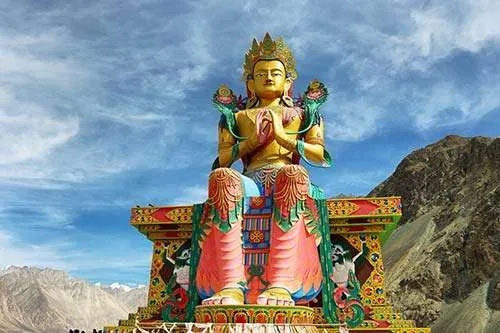
Excursion Nubra Valley: Over the Khardung La Pass, with 5360 meters the highest pass in the world that is passable all year round, the way leads down into the Nubra Valley. Even in July, the mountains surrounding Khardung La Pass are still covered with snow!
Since Nubra is on the way to a military position, existing since the 80s, to the strategically important Siachen-Glacier at the Pakistani border, the Khardung La Pass is cleared all year round and is now also accessible for tourists.
The Nubra Valley (Valley of Flowers) is the most remote and most difficult to access part of Ladak. That is why the inhabitants of the Nubra Valley live almost isolated from the rest of the world.
Until the 80’s only one caravan road (the old Silk Road) led into the Nubra Valley. Every year 10,000 animals passed through the region – loaded with Chinese silk, Indian jewelry, spices, wool, and other treasures. The caravan moved from Yarkant (China) through Nubra to exchange salt, gold brocade, and spices for cashmere wool, nuts, or vegetables.
Hard to believe, but despite its location at over 3000 meters above sea level, the Nubra Valley – due to the merging of the two rivers Nubra and Shyok – is a comparatively fertile area that is known for walnuts and apricots. It is also called the orchard of Ladakh.
At an average altitude of 4500 meters, the Changtang region is the home of the nomads. Until today they live isolated from civilization, with their sheep, yaks, goats, and horses. Kashmir goats provide the raw material for valuable handmade pashmina from this region.
The main area of Changtang lies in Tibet, where almost half a million nomads live.34
Characteristics of Cashmere Wool
The characteristics of cashmere cloth are why it is a highly desirable material for outfits. Due to the natural antibacterial properties of the wool, this fabric does not smell, even after wearing it and sweating.
It is also a hydrophilic fabric, so it absorbs liquid, making it easier to dye. However, one of the main characteristics is the fact it is nearly eight times warmer than standard Merino wool.
That’s is why you can find it in many winter products designed to keep people warm when it is 40 below zero. Finally, because this fabric is a natural fiber and biodegradable, you should never wash it in a washing machine or have it dry cleaned.
Due to cross-breeding, the United States has made a labeling requirement where specific properties must be met. According to the regulations, the wool must come from a cashmere goat, and the fibers must not exceed 19 micrometers. Our human hair is about 75 microns, dog hair for example can be as coarse as 200 microns.5
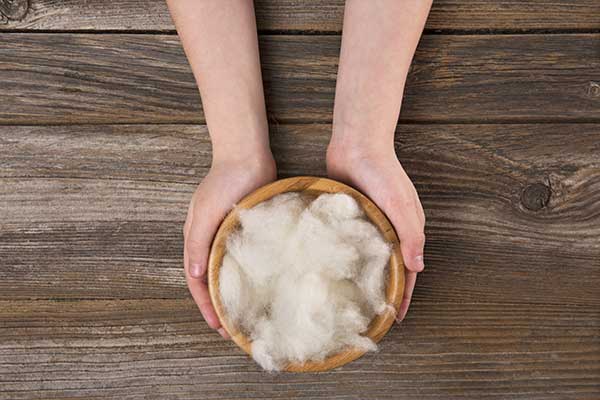
The unique Properties of Cashmere Wool
In addition to the pleasant feel on the skin, cashmere wool also scores with other properties that emphasize its exclusive character:
- In winter, cashmere wool warms particularly well – up to six times better than sheep’s wool, because the cavities of the fibers store heat perfectly.
- Moisture is quickly absorbed and wicked away to the outside – at the same time; Cashmere is water repellent.
- Cashmere wool is very flexible. If it crumples, it quickly returns to its original shape – ironing is not necessary.
- Cashmere is dirt-repellent and hardly absorbs odors — another point in favor of easy care.
- Despite the filigree fibers, cashmere wool is very robust and tear-resistant. Nevertheless, it would be best if you do not neglect proper care for Cashmere.
Identify Cashmere Counterfeits
Cashmere is a fabric that has its price already because of its natural shortage. Therefore, it often happens that products labeled “100% cashmere” sometimes do not consist of cashmere or only a small percentage or are complete counterfeits.
In general, when buying cashmere is always to consider:
- pure cashmere is matte and does not shine
- the handle should feel soapy-matte.
- the reflective body heat should soon be noticeable
- buy only from trusted dealers
For more information, please read here. →

How to tell Real Cashmere – Money Saving Tips On How To Identify Cashmere Counterfeits
How to Care for Cashmere properly
Cashmere wool, like human hair, consists of amino acids. Therefore, ideally, you should also care for cashmere, as you would for your hair: simply wash it in lukewarm water with a little wool or hair shampoo and spread it out on a terry towel to dry.
Please always lay, not hang, as this can cause the fabric to warp. Never wring or rub; otherwise, the fine hair will break! You can also machine wash cashmere – however, it is highly recommended to use the cold/wool wash cycle exclusively!
Often an extensive airing of the garments is sufficient, as cashmere is particularly odor and dirt repellent. Only in the case of heavy soiling, cleaning by a specialist company is recommended!
A lint maid can easily remove pilling knots. For more information, please read here. →
Cashmere is the most coveted fiber in the world
Cashmere wool symbolizes elegance and exclusivity, unlike any other natural fiber. Due to its outstanding quality, the material is one of the most precious fibers suitable for high-quality textiles.
Cashmere fine wool is particularly in high demand in the luxury garments market and it is used to create delicate scarves and caps as well as amazingly soft sweaters and cardigans.
If you would like to discuss Cashmere wool or any other kind of fine wool, don’t hesitate to send us a message. I will be happy to reply, share insights, or answer any questions you might have about the world’s finest wools.


The Guanaco: An Emblem of Life and Resilience in Indigenous Cultures

Activities to Enjoy at Vail Ski Resort in Ski Season 2022-23
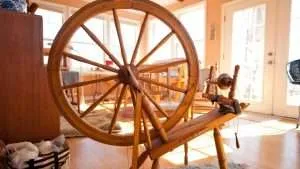
The Ultimate Guide to Wool Spinning Wheel Maintenance

Why Vicuñas Can’t Be Domesticated: The Mystery Behind the World’s Most Valuable Wool
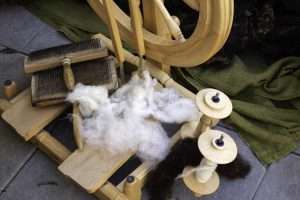
5 Factors to Consider When Choosing Yarn for Your Spinning Project
Marco Heitner
- „Kaschmirziege“. Wikipedia, URL:https://de.wikipedia.org/w/index.php?title=Kaschmirziege&oldid=191338262(6. Dezember 2019, 18:00 UTC)
- THE STAR - "Rare Himalayan goat cloned to increase cashmere wool production" by Aijaz Hussain (Thu., March 15, 2012)
- Nubra Valley, https://en.wikipedia.org/w/index.php?title=Nubra_Valley&oldid=963950815 (last visited July 3, 2020).
- Jutta Mattausch (2017), "Reise Know-How Ladakh und Zanskar" - Bielefeld: Reise Know-How Verlag
- The Fashion Robot - „Technical Characteristics of Cashmere“. (last visited Dec. 9, 2019)

